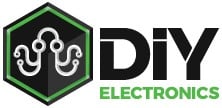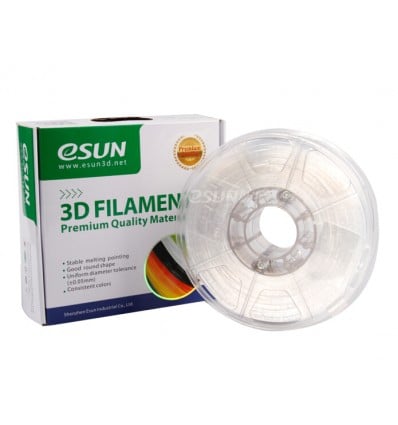International shipping Secure payment
No products
Prices are tax included
Product successfully added to your shopping cart
There are 0 items in your cart. There is 1 item in your cart.
0.5kg Spool of 1.75mm ESUN Natural Polycarbonate – Transparent 3D printer filament designed to be highly durable for new functional application possibilities.
5+ In Stock Items
Free shipping on orders over R1250 - courier delivery and within South Africa
Please Note: eSun has recently changed their filament spool material. You may receive a cardboard spool, instead of the plastic spools depicted above. This move means a more environmentally friendly design to their 3D filament spools which comfortably sit on your 3D printer's standard spool holder for smooth filament feeding.
In the world of 3D printing, there are so many different colours to choose from to create funky, exciting or otherwise tasteful prints, although there are times in which you might want to print in a completely transparent plastic. This is why our spools of Natural Polycarbonate 1.75mm 0.5kg ESUN filament are a popular choice among 3D Printing enthusiasts, as they open up many new creative possibilities for printing see-through parts and objects like covers, cases, screens and even lenses for your projects.
Aside from the fact that it’s transparent, Polycarbonate Filament also offers the benefit of being highly durable, with impressive impact strength. In fact, some PC polymers even outshine acrylic materials like PMMA, and this is achieved at less than half the density of most glass structures as well. This makes PC not only durable, but also lightweight compared to many of the alternatives on the market. And just to top off the already-impressive characteristics of Polycarbonate, eSUN have also specially formulated their ePC Filament to be fire resistant to the rating of UL94 V-2, making it ideal for all kinds of applications from high-strength decorative pieces to electronics boxes and even 3D printed soldering accessories.
eSUN Natural Polycarbonate Filament - Technical Specifications: |
|
|
– eSUN |
|
– Polycarbonate |
|
– Fire Resistant Additives |
|
– 1.75mm |
|
– 1.2 |
|
– 93 |
|
– 45(300°C/1.2kg) |
|
– 57 |
|
– 80 |
|
– 2333 |
|
– 160 |
|
– 48 |
|
– 0.5kg |
eSUN Natural Polycarbonate Filament - Suggested Print Settings: |
|
|
– 235 to 260 |
|
– Brass / Any |
|
– 0.4mm |
|
– 100 to 130 |
|
– PEI | Polycarbonate |
|
– 10 to 30 |
|
– On from Layer 2+ |
|
– Fully Enclosed |
|
– Ambient Printing Temperatures |
|
– N/A |
Helpful 3D Printing Tips for eSUN Natural Polycarbonate Filament:
As many of you will know, here at DIYElectronics, we always try to give our fullest support for every item we sell, and this includes all of the different types of 3D Filaments too. With this in mind, the following are some really useful tips that we wished we knew when we started printing with Polycarbonate, which we hope you can utilise to enjoy the great results that we’ve been working toward since first testing out this high-strength polymer:
- Polycarbonate Printing Tips – Extrusion: As an extra tip for success, we’ve found that printing with a 5:1 Line Width to Nozzle Size ratio yields excellent results with near-invisible layer lines. However, this isn’t quite as easy as it sounds, as it is in regard to the area, rather than direct size comparison, because numbers involving area need to be squared. As such, if you’re eager to print with a standard size 0.4mm nozzle, then you will want your extrusion line width to be 0.9mm, because 0.9mm squared is 0.81mm, and 0.4mm squared is 0.16mm – and of course 0.81 divided by 5 is just over 0.16. So be sure to keep this in mind if you’re printing with Polycarbonate, as these settings will not only produce beautiful aesthetics on the finished print, but will also help ensure that the layers are fused well to each other, adding value to structural integrity too.
- Polycarbonate Printing Tips – Adhesion: Additionally, although we at DIYElectronics love BuildTak, and will generally recommend it for most 3D Printing Filaments and Polymers, Polycarbonate is a little bit different, and tends to fuse with BuildTak at temperatures around 80°C and higher. And because you need a heated build surface of around 100°C to print Polycarbonate effectively, the fusing is almost unavoidable without some extra preparation such as an additional adhesive layer. As such, we will always recommend PEI instead, which holds well to Polycarbonate at temperatures between 100° and 110°C, before self-releasing the prints upon cooling down. This not only helps make 3D Printing this material easier, but also ensures no fused beds and optimal surface finishes – even on the bottom of the print.
- Polycarbonate Printing Tips – Layers: Polycarbonate filament, like ABS and a few other high-temperature polymers, tends to warp very easily if the condition aren’t just right. This means that you need to print your first layer nearly perfectly, so that the following layers have all the adhesion they need to stick, fuse and mould together in the ways they need to for strong parts. As such, it’s a good idea for your first layer to set the layer height to somewhere between 100% and 150%, with a first layer width of between 120% and 150%, as well as a first layer speed of between 15% and 30%. This will help to produce an excellent first layer, after which the following layers can simply be printed normally without any extra fuss. Additionally, when building bridges between various parts of the print, it’s important to go slow, allowing the Polycarbonate to harden as the cooling fan lightly blows on it. This will ensure strong bridges with little to no droop or sag, and overall beautiful results that are both aesthetically striking and strong.
- Polycarbonate Printing Tips – Fan Speed: Finally, the fan speed is the last important factor to consider for 3D Printing Polycarbonate, and is arguably the trickiest since many fans on hobbyist 3D Printers don’t offer real speed control. Typically, you want the fan to be off the first one or two layers, to allow the first layer to really sink in and settle, after which you want to turn the fan speed up to around 40% or so, and this should provide just enough cooling to harden the layers, but without being overbearing and causing cracking or brittleness in the finished print. However, as we mention, many fans can’t be controlled to such a degree, so consider just experimenting with whatever settings or hardware you have to try and accommodate for this if you can’t directly adjust the fan speed.
Here at DIYElectronics, we’ve had many years of experience in printing with Polycarbonate, and we hope that these top tips that we’ve gathered over the years does well in helping you get the best results and most enjoyment out of your Polycarbonate printing experience. Just remember that it is likely going to take some time to “dial in” your 3D Printer for this exotic filament, so it’s always a good idea to find as many resources and videos as you can before taking on this challenging but very rewarding polymer.
| Colour | Natural |
| Special | Transparent |
| Plastic Type | PC (Polycarbonate) |
| Plastic Diameter | 1.75mm |
| Plastic Weight | 0.5kg |
No customer reviews for the moment.
Shenzhen eSUN Industrial Co., Ltd was established in 2002 in Shenzhen Special Economic Zone and has rapidly become one of the leading international suppliers of 3D Printing Filament. They specialise in research, development and production of degradable polymer materials, and have grown their catalogue of filaments to include PLA, ABS, PC, PVA, and a wide range of other polymers and copolymers.
Their list of exclusive filament formulas include unique materials like wood, aluminium, bronze and other materials to create highly specialised filaments that can stretch, bend, be moulded or otherwise behave in very unique ways. Their filaments are also commonly characterised by their absolutely round shape, extremely low diameter tolerance, uniform colours and impressively stable melting points. These characteristics, in combination with their long-term insistent policy of “Best Quality, Reasonable Price” has garnered them a large share of the market, with their reputation commonly preceding them within knowledgeable online and offline 3D Printing communities.
eSUN’s popularity in the industry has also helped to produce sustainable partnerships with many internationally famous 3D Printer manufacturers and distributors, with DIYElectronics having sole distributorship rights to provide their 3D Printing Filaments to South Africa and neighbouring African countries.






